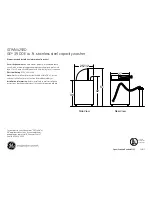
23
REMARK!
• If the lid is closed: press
release button. The lid
will spring open. Always
add the detergent just
before starting each
wash cycle.
• Only use branded deter-
gent aid for dishwasher.
Warning!
Dishwasher detergent is cor-
rosive! Take care to keep it
out of reach of children.
Proper Use of Detergent
Only use detergent specifically made for use in dishwashers.
Keep your detergent fresh and dry. Don’t put powder detergent
into the dispenser until you’re ready to wash dishes.
Fill in detergent dispenser
Fill the detergent dispenser with detergent.
The marking indicates
the dosing levels, as il-
lustrated on right:
A Location of main
wash cycle deter-
gent.
B Location of
pre-wash cycle
detergent
Please observe the
manufacturers dosing
and storage
Recommendations as stated on the detergent packaging.
Close the lid and press until it locks in place.
If the dishes are heavily soiled, place an additional detergent
dose in the pre-wash detergent chamber. This detergent will
take effect during the pre-wash phase.
REMARK!
• You see information about the amount of detergent for the
single program on table for program selection.
• Please be aware that soiling levels and water hardness can
effect wash results.
• Please observe the manufacturer’s recommendations on the
detergent packaging.
Adjusting Rinse Aid Dispenser
The rinse aid dispenser has six
or four settings. Always start
with the dispenser set on
“4”.
If spots and poor drying are a
problem, increase the amount of
rinse aid dispensed by removing
the dispenser lid and rotating
the dial to
“5” . If the dishes
still are not drying properly or
are spotted, adjust the dial to
the next higher number until your dishes are spot-free. The rec-
ommended setting is
“4”. (Factory value is “4”.)
Remark!: Increase the dose if there are drops of water or lime
spots on the dishes after washing. Reduce it if there are sticky
whitish stains on your dishes or a bluish film on glassware or
knife blades.
Detergents
There are 3 sorts of detergents
1 With phosphate and with chlorine
2 With phosphate and without chlorine
3 Without phosphate and without chlorine
Normally new pulverised detergent is without phosphate, thus
he water softener function of phosphate is not given. In this
case we recommend to fill salt in the salt container even when
the hardness of water is only 6 ∞dH. If detergents without phos-
phate were used in case of hard water often white spots appear
at dishes and glasses. In this case please add more detergent to
reach better results.
Detergents without chlorine do only bleach a little. Strong and
coloured spots will not removed completely. In this case please
choose a program with higher temperature.
Concentrated Detergent
Based on their chemical composition, detergents can be split in
two basic types:
• Conventional, alkaline detergents with caustic components.
• Low alkaline concentrated detergents with natural enzymes.
The use of Normal washing program in combination with concen-
trated detergent reduces pollution and is good for your dishes.
Detergent Tablets
Detergent tablets of different brands dissolve at different speeds.
For this reason some detergent tablets cannot dissolve and de-
velop their full cleaning power during short Programs. Therefore
please use long programs when using detergent tablets, to en-
sure the complete removal of detergent residuals.
Detergent Dispenser
The dispenser must be refilled before the start of each wash cy-
cle following the instructions provided in the Wash Cycle Table .
Your dishwasher uses less detergent and rinse aid then conven-
tional dishwasher. Generally, only one tablespoon of detergent is
needed for a normal wash load. More heavily soiled items need
more detergent. Always add the detergent just before starting
the dishwasher, otherwise it could get damp and will not dis-
solve properly.
MAX
6
5 4
3 2 1











































